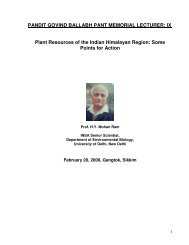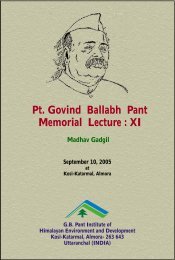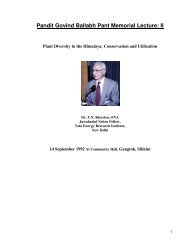PANDIT GOVIND BALLABH PANT MEMORIAL LECTURE: VII ...
PANDIT GOVIND BALLABH PANT MEMORIAL LECTURE: VII ...
PANDIT GOVIND BALLABH PANT MEMORIAL LECTURE: VII ...
You also want an ePaper? Increase the reach of your titles
YUMPU automatically turns print PDFs into web optimized ePapers that Google loves.
About Prof. K.S. Valdiya<br />
Prof K.S. Valdiya<br />
Bhatnagar Research Professor at JNCASR, Bangalore<br />
(Born 20 March, 1937 at Kalaw, Burma)<br />
Fellowships<br />
Third World Academy (Trieste)<br />
Indian National Science Academy (Delhi)<br />
Indian Academy of Sciences (Bangalore)<br />
National Science Academy (Allahabad)<br />
Written two monographs, 4 books (one in Hindi), over 85 research papers and 40<br />
popular articles in English and Hindi inn national magazines of wide circulation and<br />
repute.<br />
Social Service and Societal Involvement<br />
Deeply and intimately involved in Ecodevelopment through peoples’ participation<br />
such as development of spring sanctuaries, afforestation in village Panchayat lands,<br />
linkages of animal husbandry, horticulture and agriculture, etc. in villages in Kumaun<br />
under the aegis of an NGO since 1982. Involved in organizing and promoting<br />
Uttarakhand-wide periodic scientific meets of school and college students.<br />
Research Contributions<br />
(i) Pioneering study of cyanobacteria-built stromatolites, initiating a new line of<br />
investigation in India, leading ot fixing of age of key horizons and establishment<br />
and refinement of stratigraphic order of the sedimentary succession in the<br />
Lesser Himalaya.<br />
(ii) Studies related to genesis and chareacterizationof deposits of magnesite and<br />
associated soapstone, culminating in their large-scale mining and attendant<br />
economic development of eastern Kumaun.<br />
(iii) Comprehensive investigation of palaecurrents and basin analysis demonstrating.<br />
for the first time, that it was the north-flowing rivers draining the Aravali terrane in<br />
the Peninsular India that deposited sediments in the Himalayan basin-a finding<br />
of tremendous importance in reconstructing the palaeogeography of the Indian<br />
subcontinent during the Proterozoic Era 9 200 0 to 570 m.y. ago).<br />
(iv) Regional tectonic studies of the intracrustal boundary thrusts and India-Asia<br />
junction providing insight into the evolution and development of the Himalaya<br />
mountain, particularly with regard to the origin, characteristics, location and<br />
neotectnics of the fractured framework of the Lesser Himalayan province,<br />
buckling up of the northern edge of the Indian crust, detachment of the cover<br />
2











